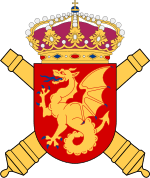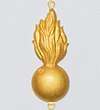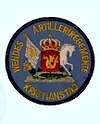Wendes Artillery Regiment
The Wendes Artillery Regiment[3] (Swedish: Wendes artilleriregemente), designation A 3, was a Swedish Army artillery regiment that traced its origins back to the 17th century. The regiment's soldiers were originally recruited from Scania, where it was garrisoned. The unit was disbanded as a result of the disarmament policies set forward in the Defence Act of 2000.
| Wendes Artillery Regiment | |
|---|---|
| Wendes artilleriregemente | |
 | |
| Active | 1794–2000 |
| Country | |
| Allegiance | Swedish Armed Forces |
| Branch | Swedish Army |
| Type | Artillery |
| Size | Regiment |
| Part of | 1st Military District (1833–1893) I Army Division (1893–1901) I Army Division (1902–1927) Southern Army Division (1928–1936) I Army Division (1937–1942) I Military Area (1942–1966) Southern Military Area (1966–2000) |
| Garrison/HQ | Hässleholm |
| Motto(s) | Nulli secundus ("Second to none") |
| Colors | Blue and white |
| March | "Siegestrophäen" (Friedemann)[note 1] |
| Anniversaries | 6 September[note 2] 4 December[note 3] |
| Battle honours | Großbeeren (1813) Dennewitz (1813) Leipzig (1813) |
| Insignia | |
| Branch insignia |  |
| Shoulder sleeve insignia m/1906 |  |
| Shoulder sleeve insignia |  |
History
The regiment has its origins in the Artillery Regiment raised in 1636. That regiment was split into four new regiments in 1794 of which Wendes Artillery Regiment was one. The regiment was given the designation A 3 (3rd Artillery Regiment) in 1830. In 1893 two companies were split off to form 2nd Svea Artillery Regiment and 2nd Göta Artillery Regiment. The regiment was garrisoned in Kristianstad but moved to Norra Åsum in 1953 and to Hässleholm in 1994 before being disbanded in 2000.
Campaigns
- ?
Organisation
- ?
Heraldry and traditions
Colours, standards and guidons
The standard of Wendes Artillery Regiment was embroidered by hand by mademoiselle Anette Bergner and presented as an honorary standard to the former mounted division of the Royal Wendes Artillery Regiment (A 3) in 1815. It was used as regimental standard by A 3 until 1 July 2000.[4] Blazon: "On white cloth a winged cluster of flashes clasped by a hand under a royal crown proper, wings brown, crown and flash-cluster in yellow. In each corner a slanted open yellow crown. Yellow battle honours (Großbeeren 1813, Leipzig 1813, Dennewitz 1813) on the three lower sides of the standard. Fringe in white and yellow." Today it is presented as the second standard of the Artillery Regiment.[4]
 Regimental standard
Regimental standard
Commanding officers
- 1794–1797: C C Gyllenstierna
- 1797–1804: C Armfelt
- 1804–1807: J Norby
- 1807–1821: Carl Friedrich von Cardell
- 1821–1822: C A Hägerflycht
- 1822–1845: A G von Arbin
- 1845–1860: David Wilhelm Silfverstolpe
- 1860–1866: A Wachtmeister
- 1866–1871: C M Skytte
- 1871–1882: G M von Arbin
- 1882–1883: H E R Rehbinder
- 1883–1891: A O Ankarcrona
- 1891–1895: C A Francke
- 1895–1911: Fredrik Johan Leth
- 1903–1911: T J Dyrssen
- 1911–1918: Karl Toll
- 1918–1919: G A Lundeberg (acting)
- 1919–1922: Bo Tarras-Wahlberg
- 1922–1927: Lennart Lilliehöök
- 1928–1932: Thor Lagerheim
- 1932–1935: Sture Gadd
- 1935–1940: Hugo Gadd
- 1940–1945: Knut Gyllenstierna
- 1945–1950: Tor Hedqvist
- 1950–1951: Karl Ångström
- 1951–1954: Erik Kihlblom
- 1954–1957: Alarik Bergman
- 1957–1961: Nils Söderberg
- 1961–1963: Stig Löfgren
- 1963–1966: Stig Magneberg
- 1966–1966: Carl Arcadius Holger Areskoug (acting)
- 1966–1967: Harald Smith
- 1967–1978: Valter Thomé
- 1978–1986: Hans Richter
- 1986–1993: Leif Mårtensson
- 1993–1994: Kjell Åke Plantin (acting)
- 1994–1995: Kjell Åke Plantin
- 1995–2000: Rolf Ohrlander
Names, designations and locations
| Name | Translation | From | To | |
|---|---|---|---|---|
| Kungl Wendes artilleriregemente | Royal Wendes Artillery Regiment | 1794-06-23 | – | 1974-12-31 |
| Wendes artilleriregemente | Wendes Artillery Regiment | 1975-01-01 | – | 2000-06-30 |
| Avvecklingsorganisation | Decommissioning Organisation | 2000-07-01 | – | 2001-06-30 |
| Designation | From | To | ||
| № 3 | 1830-??-?? | – | 1914-09-30 | |
| A 3 | 1914-10-01 | – | 2000-06-30 | |
| Location | From | To | ||
| Kristianstad Garrison | 1794-06-23 | – | 1994-06-30 | |
| Stralsund Garrison | 1794-06-23 | – | 1814-12-31 | |
| Hässleholm Garrison | 1994-07-01 | – | 2000-06-30 |
See also
Footnotes
- The march was established in 1953 by Army Order 33/1953.[1]
- 6 September is the anniversary of the Battle of Dennewitz.
- 4 December is saint day of Saint Barbara.[2]
References
Notes
- Sandberg 2007, p. 32
- Braunstein 2003, pp. 189–191
- Gullberg 1977, p. 1141
- Braunstein 2004, pp. 55-56
- Braunstein 2006, p. 32
Print
- Braunstein, Christian (2003). Sveriges arméförband under 1900-talet. Skrift / Statens försvarshistoriska museer, 1101-7023 ; 5 (in Swedish). Stockholm: Statens försvarshistoriska museer. ISBN 91-971584-4-5. SELIBR 8902928.CS1 maint: ref=harv (link)
- Braunstein, Christian (2004). Svenska försvarsmaktens fälttecken efter millennieskiftet [The flags and standards of the Swedish armed forces after the turn of the millennium] (PDF). Skrift / Statens försvarshistoriska museer, 1101-7023 ; 7 [dvs 8] (in Swedish). Stockholm: Statens försvarshistoriska museer. ISBN 91-971584-7-X. SELIBR 9815350.CS1 maint: ref=harv (link)
- Braunstein, Christian (2006). Heraldiska vapen inom det svenska försvaret [Heraldry of the Swedish Armed Forces] (PDF). Skrift / Statens försvarshistoriska museer, 1101-7023 ; 9 (in Swedish). Stockholm: Statens försvarshistoriska museer. ISBN 91-971584-9-6. SELIBR 10099224.CS1 maint: ref=harv (link)
- Gullberg, Ingvar E. (1977). Svensk-engelsk fackordbok för näringsliv, förvaltning, undervisning och forskning [A Swedish-English dictionary of technical terms used in business, industry, administration, education and research] (in Swedish) (2nd ed.). Stockholm: Norstedt. ISBN 91-1-775052-0. SELIBR 8345587.CS1 maint: ref=harv (link)
- Sandberg, Bo (2007). Försvarets marscher och signaler förr och nu: marscher antagna av svenska militära förband, skolor och staber samt igenkännings-, tjänstgörings- och exercissignaler (in Swedish) (New ed.). Stockholm: Militärmusiksamfundet med Svenskt marscharkiv. ISBN 978-91-631-8699-8. SELIBR 10413065.CS1 maint: ref=harv (link)
Further reading
| Wikimedia Commons has media related to Wendes Artillery Regiment. |
- Mankell, Julius (1866). Anteckningar rörande svenska regementernas historia (in Swedish) (2nd ed.). Örebro: Lindh. pp. 146–166. SELIBR 1549756.
- Ossiannilsson, Sölve (1944). Wendes regementes historia (in Swedish). Kristianstad: [Littorins bokh.] SELIBR 8219641.
- Scheutz, Sven, ed. (1993). Kunglig Wendes artilleriregementes historia 1794-1994 (in Swedish). Kristianstad: Wendes artilleriregemente. SELIBR 1837655.
- Scheutz, Sven (2004). Kungl Wendes artilleriregementes underofficerskår 1794-1972 och kompaniofficerskår 1972-1983 (in Swedish). Kristianstad: Wendes militärhistoriska förening. SELIBR 9793847.
- Scheutz, Sven; Weinsjö, Ulf (1998). Kungl Wendes artilleriregementes officerskår 1794-1972 (in Swedish). Kristianstad: Wendes militärhistoriska fören. SELIBR 2645342.
- Vultée, Lars Åke von; Wollinger, Susanne; Jönsson, Janne (1994). A 3: sista året i Norra Åsum (in Swedish). [Kristianstad]: [Zebra]. ISBN 91-630-3125-6. SELIBR 7450406.
- Ask, Olle; Nyberg, Lennart, eds. (2000). Wendes sista år (in Swedish). Hässleholm: Wendes artilleriregemente. ISBN 91-631-0312-5. SELIBR 7455245.